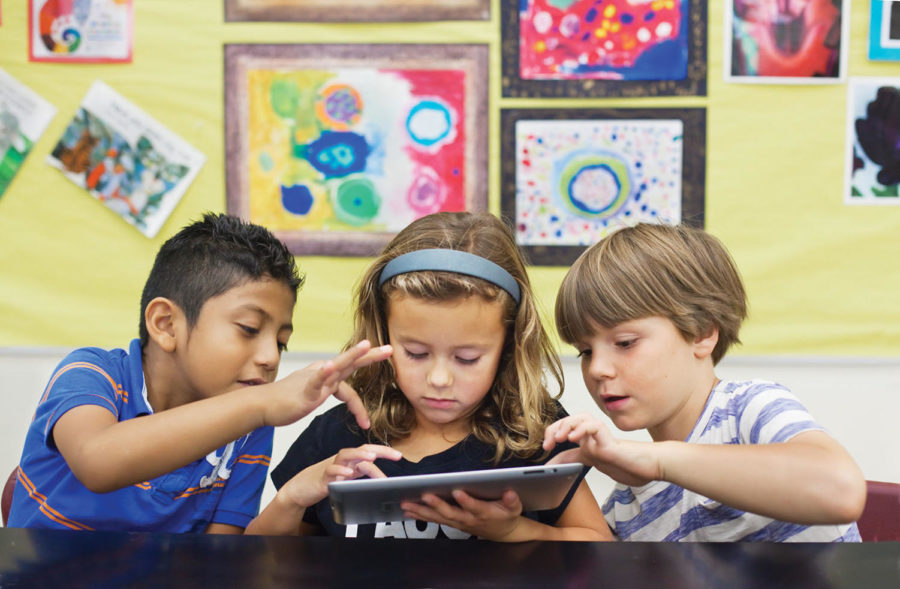Tykes use tech
Are iPads in elementary schools helping with learning development, or ruining an already stable system?
Photo by Provided by Marnie Cooke
September 1, 2019
The constant light which glares from a screen to illuminating tapping on separate keys, the devices are well known upon students, teachers, and parents of Noblesville High School.
Although most highschool students have grown accustomed to IPads and how to learn from them, the overall aspect of kindergarten through second grade students using them seemed almost unnecessary. When the launch of elementary school students using iPads became apparent, many worried how this could work. Would it cause problems? Would the students be getting too much screen time? Why do the elementary school need it? How much are the teachers really teaching in a kindergarten classroom? And, are the iPads taking over?
Even with so many questions negatively towards the elementary school students using iPads, White River, kindergarten teacher, Jenna Purdue, believes when used properly they are a great tool for learning.
“I like the kids having access to them at school. They are a great tool and being able to get our hands on them whenever we need/want is great! One on one is interesting though in kindergarten,” Perdue says. “I have some hesitations about it because many of our young students have so much screen time at home that I try to avoid giving them too much more at school.”
Teachers know how too much screen time can affect students so they try to set a curriculum that gives the students a chance to use iPads during certain activities for an amount of time so they can exceed learning but also make sure screen time isn’t too heavy.
“I use the iPads as an occasional resource. On most days, my kindergarteners do not use them,” Perdue continues. “The iPads are one of our station activities, so every 6 days students get 15-20 minutes on an app of my choosing usually revolving around literacy or math skills that we are working on. I would say 95% of my instruction is still done by me versus the iPads.”
While iPads are used in group activities, this does not mean they do not help individual education as they allow students to individually open their minds and learn what they couldn’t on paper.
“Sometimes I use them for whole group activities, but mainly they are used as a reinforcement tool for students to put the knowledge they have already learned to work by creating something,” Perdue explains. “They are also used as a reinforcement and supplementation tool in small groups.”
Kristin Patrick, technology integration coach for the noblesville schools district, explains while teachers are provided the opportunity to use iPads in the classroom during activities, if paper and pencil works better they are encouraged to use a more “old school” approach rather than technology.
“Only picking it up when it makes sense. So we use a framework called the triple E framework, where we ask teachers to reflect on some indicators regarding engagement, extending the learning goals and enhancing the learning experience,” Patrick explains. “And if it doesn’t meet these requirements, then we encourage the teachers to pause and maybe reconsider using technology.”
While this aspect is in place, Jen Townsend, The Director Of Learning for the noblesville elementary and middle schools, goes into detail on not only the learning development students have from using IPads, but the social impact they are gradually growing.
“The skills that are really expected in career choice of when you go into the workplace and the idea of collaboration and working with others; you no longer just work in your bubble, you are connecting all the time,” Townsend says. “When we are thinking about those skills and how they are so important for their future, that’s where we are seeing the enhanced learning happening.”
While students are working together, they develop a sense of collaboration with the iPads that they may have not had before.
“We are looking at how are we getting kids ready for the real world, to be collaborative, to be creative, to be able to ask questions and to think about different perspectives; that is really important,” Townsend says.
With this idea that a platform is there for students to have discussions over a broader audience, Kristin adds the overall impact this can have on their future working with technology.
“We want that idea of a discussion forum, we want kids to make mistakes now before the stakes are higher. When they mess up on that discussion forum, then we can teach into it before they put it on social media or anything else as they get older.”
With IPads now in k-12, the growing concern that students are developing their minds less with iPads at a young age has been negotiated with details supporting how iPads are positively impacting younger students of this generation. As the years come, there is much to develop and maintain a perfect pace with education and technology, but iPads seem to have made a dent in the elementary school classrooms and are looking to stay.




